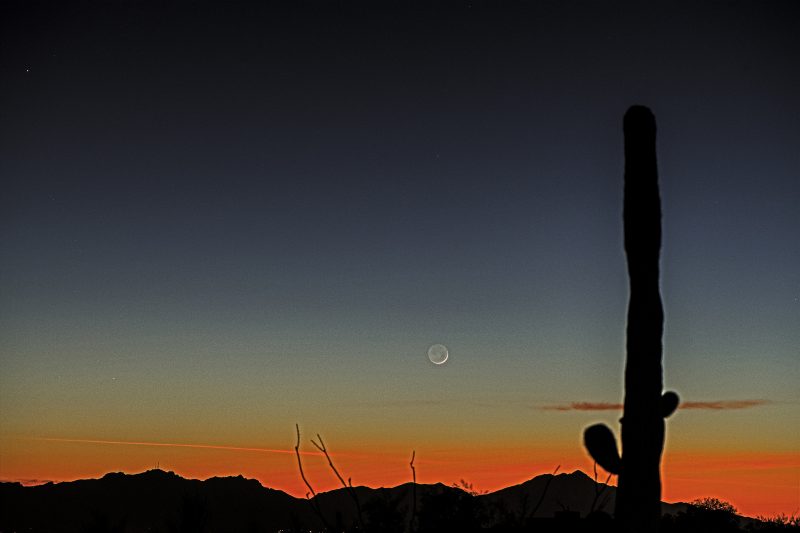Maybe you saw the planet Mercury last week, near Jupiter and Saturn, when these three worlds formed a planetary trio? Now Jupiter and Saturn are difficult to see in the glare of twilight (though you might still snag bright Jupiter with binoculars, shortly after the sun goes down). And, meanwhile, Mercury has ascended higher in the western twilight. On January 14, 15 and 16, 2021, the innermost planet will be near the waxing crescent – or young moon – which is just returning to the evening sky after new moon on January 12-13. Find an unobstructed horizon in the direction of sunset, and look for the moon and Mercury to pop out into the evening twilight as dusk ebbs into darkness. The nearby bright star will be Fomalhaut in Piscis Austrinus the Southern Fish. Fomalhaut is sometimes called the Loneliest Star, but it’s not so lonely now!
Don’t dally when searching for the moon on January 14; from most spots worldwide, the wispy slender crescent (and Mercury) will follow the sun beneath the horizon before nightfall (before the end of astronomical twilight).
Want to know the moon’s setting time in your sky?
Live in the U.S. or Canada? Click on Old Farmer’s Almanac.
For virtually anywhere worldwide, try TimeandDate for moonset times.
Note that setting times, on both sources listed above, presume a level horizon.
Here are the approximate setting times for Mercury over the next several days at various latitudes:
40 degrees north latitude: Mercury sets 1 1/4 hours (1 hour and 15 minutes) after the sun
Equator (0 degrees latitude): Mercury sets 1 1/10 hours (1 hour and 6 minutes) after the sun
35 degrees south latitude: Mercury sets 1 hour (60 minutes) after the sun
Want more specific information? Again, try the Old Farmer’s Almanac or TimeandDate.
Given clear skies and an unobstructed horizon, chances are that you’ll see both the moon and the planet Mercury with the eye alone. If you miss the skinny, pale crescent on January 14, try again on January 15 and 16, as a wider and brighter lunar crescent shines higher up at sundown and stays out longer after dark. Keep in mind that the illuminated side of the waxing crescent moon will be pointing right at Mercury.
Mercury now ranks as the second-brightest “star” (really, planet) of the night sky, after Sirius, the Dog Star. Despite Mercury’s brilliance, Mercury still sits rather close to the horizon after sundown, and the solar system’s innermost world must contend with the afterglow of evening twilight. If you can’t see Mercury with the unaided eye, try your luck with binoculars. We think you’ll spot it, though.

When we view the moon as a waxing crescent in our sky – as now – someone on the moon would view Earth in an almost-full waning gibbous phase. In this way, the moon is a sort of “mirror” to Earth. The phases are always in sync between our two worlds, albeit oppositely expressed!
With a waning gibbous Earth in its sky, sunlight reflected from Earth strikes the moon’s near side strongly now. That reflected sunlight is then bounced back toward Earth. That’s why – when we on Earth see a waxing crescent moon – the moon’s dark or nighttime side softly glows with what’s called earthshine. Watch for earthshine on the moon around now. Binoculars will enhance your view.
Although Mercury is now dimming slightly day by day, it’ll also continue to climb farther away from the setting sun until reaching its greatest eastern (evening) elongation – its maximum angular distance of 18.6 degrees – from the sun on January 24, 2021 (evening of January 23, 2021, for the Americas).
Expect Mercury to be in good view at evening dusk for another few weeks!
Bottom line: The moon and Mercury pair up most closely on January 14, 2021, on the day that the newly-born moon first appears in the January 2021 evening sky. On the following days – January 15 and 16, 2021 – let the lit side of the waxing crescent moon serve as your arrow in the sky, as it points to Mercury’s whereabouts near the horizon.











